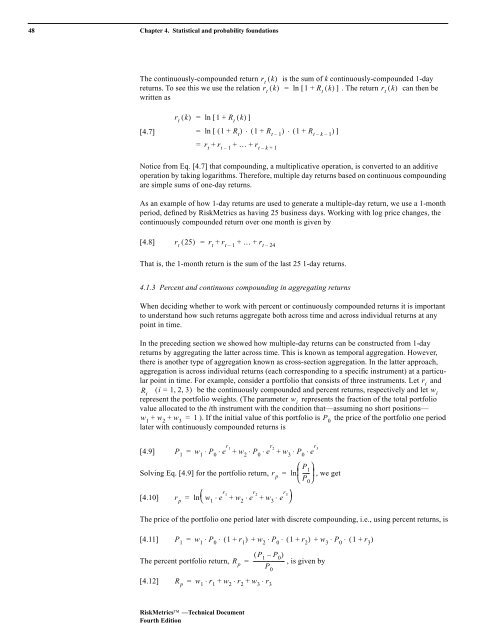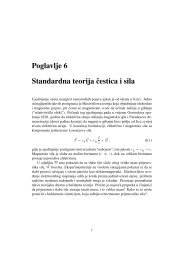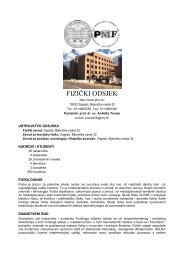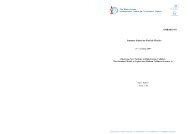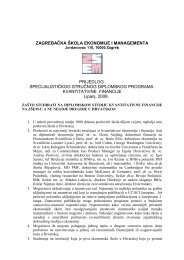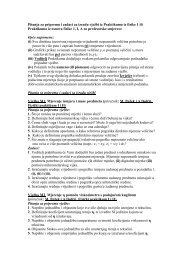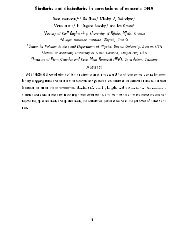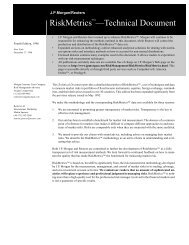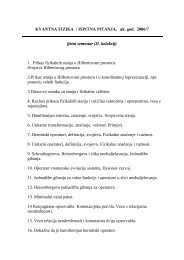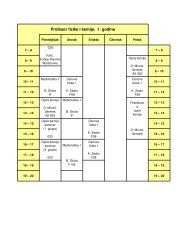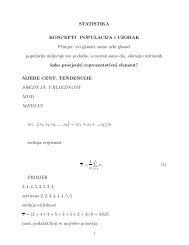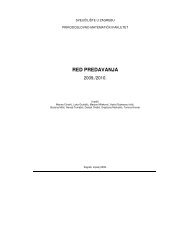RiskMetrics⢠âTechnical Document
RiskMetrics⢠âTechnical Document
RiskMetrics⢠âTechnical Document
Create successful ePaper yourself
Turn your PDF publications into a flip-book with our unique Google optimized e-Paper software.
48 Chapter 4. Statistical and probability foundations<br />
The continuously-compounded return r t<br />
( k)<br />
is the sum of k continuously-compounded 1-day<br />
returns. To see this we use the relation r t<br />
( k) = ln [ 1+<br />
R t<br />
( k)<br />
] . The return r t<br />
( k)<br />
can then be<br />
written as<br />
[4.7]<br />
r t<br />
( k) = ln [ 1+<br />
R t<br />
( k)<br />
]<br />
= ln [ ( 1 + R t<br />
) ⋅ ( 1+<br />
R ) 1 R t – 1<br />
⋅ ( + t – k –<br />
)]<br />
1<br />
= r t<br />
+ r t – 1<br />
+ … + r t k<br />
– + 1<br />
Notice from Eq. [4.7] that compounding, a multiplicative operation, is converted to an additive<br />
operation by taking logarithms. Therefore, multiple day returns based on continuous compounding<br />
are simple sums of one-day returns.<br />
As an example of how 1-day returns are used to generate a multiple-day return, we use a 1-month<br />
period, defined by RiskMetrics as having 25 business days. Working with log price changes, the<br />
continuously compounded return over one month is given by<br />
[4.8]<br />
r t<br />
( 25) = r t<br />
+ r t – 1<br />
+ … + r t – 24<br />
That is, the 1-month return is the sum of the last 25 1-day returns.<br />
4.1.3 Percent and continuous compounding in aggregating returns<br />
When deciding whether to work with percent or continuously compounded returns it is important<br />
to understand how such returns aggregate both across time and across individual returns at any<br />
point in time.<br />
In the preceding section we showed how multiple-day returns can be constructed from 1-day<br />
returns by aggregating the latter across time. This is known as temporal aggregation. However,<br />
there is another type of aggregation known as cross-section aggregation. In the latter approach,<br />
aggregation is across individual returns (each corresponding to a specific instrument) at a particular<br />
point in time. For example, consider a portfolio that consists of three instruments. Let r i<br />
and<br />
R i<br />
( i = 123 , , ) be the continuously compounded and percent returns, respectively and let w i<br />
represent the portfolio weights. (The parameter w i<br />
represents the fraction of the total portfolio<br />
value allocated to the ith instrument with the condition that—assuming no short positions—<br />
w 1<br />
+ w 2<br />
+ w 3<br />
= 1). If the initial value of this portfolio is P 0<br />
the price of the portfolio one period<br />
later with continuously compounded returns is<br />
[4.9] P 1<br />
w 1<br />
P 0<br />
e r 1<br />
⋅ ⋅ w 2<br />
P 0<br />
e r 2<br />
⋅ ⋅ w 3<br />
P 0<br />
e r 3<br />
=<br />
+ + ⋅ ⋅<br />
⎛P 1<br />
⎞<br />
Solving Eq. [4.9] for the portfolio return, r p<br />
= ln⎜-----<br />
⎟ , we get<br />
⎝ ⎠<br />
⎛<br />
[4.10] r p<br />
w 1<br />
e r 1<br />
⋅ w 2<br />
e r 2<br />
⋅ w 3<br />
e r 3⎞<br />
= ln⎝<br />
+ + ⋅ ⎠<br />
The price of the portfolio one period later with discrete compounding, i.e., using percent returns, is<br />
P 0<br />
[4.11]<br />
P 1<br />
= w 1<br />
⋅ P 0<br />
⋅ ( 1 + r 1<br />
) + w 2<br />
⋅ P 0<br />
⋅ ( 1+<br />
r 2<br />
) + w 3<br />
⋅ P 0<br />
⋅ ( 1+<br />
r 3<br />
)<br />
( P<br />
The percent portfolio return, R 1<br />
– P 0<br />
)<br />
p<br />
= ------------------------ , is given by<br />
P 0<br />
[4.12]<br />
R p<br />
= w 1<br />
⋅ r 1<br />
+ w 2<br />
⋅ r 2<br />
+ w 3<br />
⋅ r 3<br />
RiskMetrics —Technical <strong>Document</strong><br />
Fourth Edition


